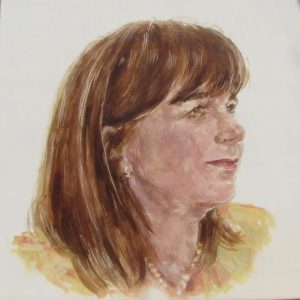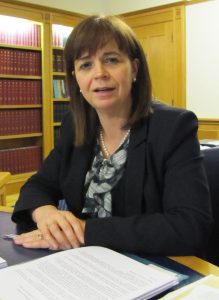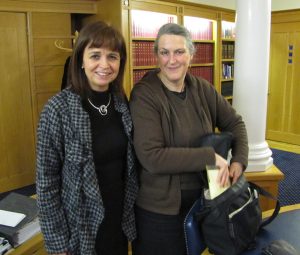
Herstory: Elish Angiolini
Interview 24 January 2011
Location: Lord Advocate’s Chambers, Crown Office, Edinburgh UK
Present: Elish Angiolini, Frances Robertson and Sharon Thomas

Elish Angiolini photo portrait, 2011
Elish Angiolini is the first woman Lord Advocate of Scotland, the chief legal officer of the Scottish Government and of the Crown in Scotland. She was appointed in October 2006 and her post will run until May this year. The portrait sittings have all taken place in her rooms in the Crown Office in Edinburgh, an imposing nineteenth century building in Chambers Street, constructed first as the Watt Institute and then expanded to form a part of Heriot-Watt University, before it was taken over and refurbished for its current purpose. Before entering the Crown Office, then, one is greeted with busts of industrial heroes on the façade, and the main entrance is topped not by a figure of blind Justice, but by a busy hammering smith at an anvil. The interior decorations have a more legalistic theme however, with one area containing a display of images of many of the past Lord Advocates. Although some of these images have been taken from what appear to be official portraits, rendered in print reproductions such as copper engravings of mezzotints, several images have come from much more informal sources such as topical caricatures or comical news stories of their periods.
Elish’s portrait, which will likely be in form of a colour photograph, will join these ranks of men when she leaves her post in May 2011. With this in mind I ask whether, apart from the series that Sharon is working on, if she has ever had a portrait made before? In response Elish laughs to recall that she certainly has had her portrait drawn when she was seventeen whilst on holiday with her sister in Paris. She describes being approached by one of the many street artists who flock around Montmartre rendering portraits for the tourist trade; it had been fun, and of course, quite a flattering experience! More recently a photographic portrait was shown in the exhibition of ‘Women in Scotland’ at the Scottish National Portrait Gallery and is now part of their collection. Beyond the portrait genre, we also wonder whether art features much in her life, as an interest or relaxation. Elish answers that unfortunately not, especially at present while she remains in post; as the job is so demanding and so constant that any spare time she gets is focused on her family. The closest she gets to ‘art’ activities are in fact through her family, by proxy, when she admires and displays her children’s drawings; and like many working parents Elish has a few of these as a cheerful presence in her office as we look around the room.
Elish’s own interest in the law began when she was still a teenager growing up in Govan. Her father had run a coal-merchant’s business there that did not survive the changes in demand following the Clean Air Acts of the 1960s. In parallel with the decline in the family fortunes, the whole area of Govan also fell into decline with the collapse of shipbuilding in the 1970s; Elish recalls taking the ferry across to the north side of the river to school and the silence of the yards, a very obvious contrast to the lively, noisy and thriving area that had been the background to her earlier childhood. Alongside the growing unemployment came more social problems and crime. At one point, their family home was burgled, along w ith many others in the street, requiring Elish as a court witness. For Elish this was a striking experience, notably for the way in which the impersonal and alien workings of the court system proved to be highly intimidating and alien to witnesses and victims rather than, as it was intended to be, to those accused of crimes. This insight has never left her, so that when she began to work for the Crown Office and Procurator Fiscal Service after her training this prompted new thoughts on how vital it was for prosecution services to offer support to victims and witnesses. In part she was able to develop new insights into the workings of the legal system and the full ramifications of how victims and witnesses were overlooked because she was a woman.
When Elish started work, as a ‘female 23-year-old prosecutor’, the cases that were seen as ‘least important’ such as child abuse or domestic violence, were directed to Elish for attention. Initially Elish noticed that over and again victims of child abuse kept on going back to their abusers, and at that time there was no framework to understand why this happened, beyond making the victim complicit in the crime. She researched the mechanisms by which child abusers manipulated their victims, and also spent some time in America, studying their methods of working with young and damaged victims, both in getting evidence and in the set-up of the court itself for such cases.

Elish Angiolini and Frances Robertson, 2011.
Fortunately, attitudes are changing slowly; demanding chief detectives and lawyers, men and women, rather than the youngest and most inexperienced trainees in these fields, work on such cases. But this has taken a lot of work. Thirty years ago when Elish began her career, domestic violence and child abuse were seen as ‘private issues’. Outside lobby groups such as the ‘Zero Tolerance Campaign’ have helped to drive changes in this area, but there is still a lot to be done in a contested and very problematic area. Typically it will still take about 30 physical attacks, for example, before a victim will report domestic violence, not counting the effects of verbal abuse that had most probably preceded this.
But for Elish as Lord Advocate, the topic of female abuse is one arc of a multi layered spectrum of issues.
Legislation for Environmental and wildlife law is one large area under her supervision, demanding that she equally consider rights of the bumble bee with that of farming legislation or banking fraud. In particular reference to financial misdemeanours, Elish believes that the tidy sounding ‘white collar crime’ is on equal level in terms of lawlessness to every other form of crime. Taking an overview of the law in this way has allowed Elish to reflect on how to respond to public perceptions and fears, for example, anti-social behaviour, a mass of apparently small and insignificant acts, is nevertheless a major headache for most people and their main contact with criminal activity. The most difficult things about seeing the whole of the prosecution services is to be able to see what areas need researching or change, but to be aware that the system is so hard-pressed for time and resources that training and development are difficult to fit in.
But to return to the subject of Women, asking particularly which women have been an inspiration or who have been good companions in her own work and formation? Elish answers that amongst the key strong women that she applauds Ruth Wishart, Liz Lochhead, and Elaine C. Smith rank very highly. Focusing particularly in Law, inspirational women feature Helena Kennedy QC, an example that Elish offers of how to work to the highest standard as a woman whilst being relatively isolated in a male world; and finally Lady Cosgrove, (Hazel Cosgrove) who was appointed the first woman Senator to the College of Justice in 1996 and hence the first woman judge in Scotland’s Supreme Courts. For Elish, Lady Cosgrove is an important figure in her career in respect to her strength and success: providing Elish with ‘warmth, support and encouragement’ to pursue her own career. A career that has reached a pinnacle title: as first female Lord Advocate in Scottish legal history in 550 years.
Frances Robertson, 2011
Copyright Frances Robertson
